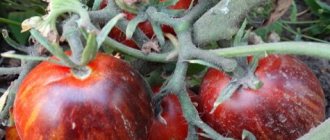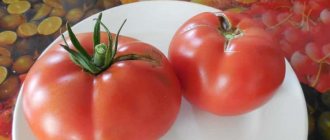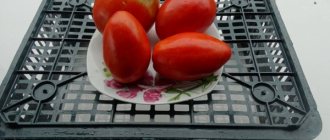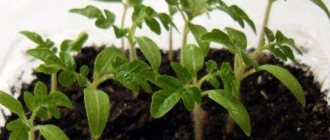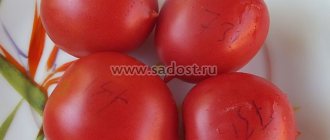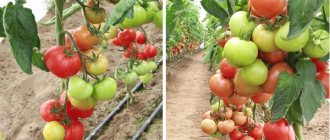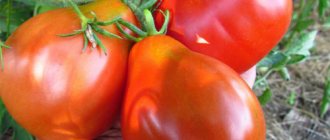Bull's eye is a well-known, sought-after hybrid among mid-early tomatoes. Belongs to the cherry group, has a beautiful, presentable shape and excellent taste.
| Height | Landing location | Ripening time | Fruit color | Fruit size | Origin | Fruit shape |
| Tall | Greenhouse, Open ground | Mid-early | Reds | Small | Hybrid | Round |
Ripening dates and growing regions
The tomato has early ripening periods (90-95 days), and therefore is especially valued in regions with a long spring and late summer. But it is successfully cultivated throughout Russia. The variety is characterized by a long fruiting period, so it is more advisable to grow it in closed ground conditions. In glass and film greenhouses in mid-latitudes, “Bull’s Eye” will produce crops until frost, and in greenhouses with heating and lighting, the growing season can last more than one year. In regions with long and warm summers, the tomato will have time to produce a good share of the harvest in open ground.
Common problems and their solutions
Fortunately, Bull's Eye is not highly susceptible to pathogens of certain tomato diseases, for which we should first of all thank the breeders who created it. At the same time, the tomatoes in question are not completely invulnerable, sometimes suffering from such common misfortunes as:
- Late blight. This fungal disease is characterized by gray-brown spots that appear first on the foliage and then on the stems and berries of the plant. If proper measures are not taken, this disease will lead to the loss of most of the crop, developing especially actively in warm and humid conditions.
- Alternaria blight. The second name for the disease in question, which is also fungal, is brown or dry spotting. It affects all above-ground organs of tomato bushes, spreading from bottom to top. The disease most often occurs in greenhouse conditions, being capable of destroying up to 2/3 of the crop.
Cherry tomatoes. Review of 9 varieties
Tomato "Bull's forehead"
PREPARING TOMATOES - FAST, HEALTHY, WITHOUT BOILING!!1
Considering the fungal origin of both diseases, they can be fought with the same means. These are broad-spectrum fungicides, the effectiveness of which in combating such infections is beyond doubt (provided that measures are taken in a timely manner). One of these drugs that can “boast” the best results is Ordan, which can be used both for the total extermination of a microscopic threat and for prevention purposes.
Characteristics of the plant and characteristics of the fruits
The variety is indeterminate, plant height in open ground reaches 2 meters, growth in a greenhouse is unlimited. A plant without a formation procedure branches very much. Stepchildren are formed in the axils of the leaves, and peduncles are formed on the shoots outside the axils. The stems of young bushes are soft, light green in color, but as they grow they become lignified and, if not tied up, lie down.
The brush that will produce the first tomatoes is placed above the 7-8 leaf, the second - after 2 leaves. The first two clusters are simple with 10-12 fruits, the subsequent ones are formed after 1-2 leaves and bear 30-40 tomatoes each. The flowers are large; in inflorescences they bloom one after another, which ensures almost simultaneous ripening of tomatoes in one cluster.
The fruits are the same size, round in shape and average weight not exceeding 30 grams. Fully ripe tomatoes are juicy red in color with a smooth glossy surface. The pulp is two-chambered, sweet and juicy. The peel is very delicate and soft. The fruits have a high content of lycopene and sugars (more than 4.5%).
The productivity of the variety is high.
In greenhouse conditions it is 10-12 kg per square meter, in open ground 7-8 kg. Fact! Cherry fruits contain about 8% dry matter, 4% of which is sugar, the rest is shared by proteins, organic acids, and essential oils. Also, these tomatoes, unlike large-fruited ones, are record holders for the content of various vitamins.
Resistance to pests and diseases
The type of tomato in question is resistant to the following types of destructive influences:
- This variety effectively resists root-knot nematodes.
- Not “afraid” of verticillium.
- Resistant to BTM.
- Effectively resists fusarium and cladosparia.
Tomato has weak immunity to fungal diseases such as late blight, powdery mildew, and cladosporiosis.
Methods of treatment and prevention
Powdery mildew (also called Belle) is accompanied by a white coating of mycelium on the leaves. It received the name “dew” because after the spores ripen, drops of moisture form on the leaves.
Mainly leaves, stems, shoots and fruits are affected. Soil stains begin to appear and are transferred to the entire plant.
The ideal environment for this disease is low air humidity. It is for this reason that frequent light watering is recommended.
The drug “Tiovit Jet” is used for treatment.
Cladosporiosis. The first symptoms of the disease are yellow spots on the upper sides of tomato leaves. The lower ones have a brown coating. Shrinking of flowers and fruits.
There are no drugs for treatment; prevention methods cannot be neglected.
- The area should be cleared of any tomato residue;
- Old leaves on the plant must be removed;
- If you notice the first spots, immediately, 2 times a day, treat the plant with preparations that contain copper.
Purpose of the variety
Cherry tomatoes are used whole or in halves to decorate meat dishes, salads, and appetizers. Thanks to the sweet dessert taste, the fruits can be used not only in regular vegetable salads, but also in fruit and berry salads.
According to its characteristics, “Bull’s Eye” is ideal for drying. Skillful housewives have adapted to drying tomatoes at home using electric dryers, ovens and convection ovens. In winter, such preparation will give any dish a unique taste and aroma.
Using these small and strong tomatoes, you get not only tasty, but also beautiful preservation. Preparations with cherry tomatoes “on a branch” look especially impressive.
Both adults and children eat Bull's Eye tomatoes in their natural form. Even those children who do not like vegetables enjoy eating them.
It is also profitable to grow this variety for commercial purposes. A long growing season and high yields allow for good profits. In addition, the price for this variety of tomatoes is always an order of magnitude higher, and demand remains at a consistently high level all year round.
The most reliable navigators according to customers
Navigator Garmin GPSMAP 64 on Yandex Market
Navigator Garmin Montana 680 on Yandex Market
Mariner NAVITEL G550 Moto on Yandex Market
Garmin eTrex Touch 35 navigator buy on Yandex Market
Garmin Oregon 750 navigator on Yandex Market
(how) like choosing a GPS navigator - on ZdavNews.ru
Long gone are the days when all housework was done manually. Household skills have become our reliable assistant in housekeeping. Tireless electric “workers” help cook food, wash clothes, wash dishes, restore order and cleanliness, making our lives cruelly easier
However, in order for homework to continue and progress beyond interruptions, it is important to select the right devices, paying attention to production volume, speed, functionality, number of modes and other operational characteristics. How to avoid common mistakes when purchasing this or that equipment, how to use it correctly, which models are considered the best, and no worse than anyone to find the cause of the breakdown and repair the device yourself. Comprehensive material is presented about all types of equipment: both small and large, both budget and expensive, both domestic and foreign.
Read useful articles and replenish your knowledge about household appliances with new valuable information!
Comprehensive material is presented about all types of equipment: both small and large, both budget and expensive, both domestic and foreign. Read useful articles and replenish your knowledge about household appliances with new valuable information!
Share the link and your bros will know that you know the answers to all questions. Grateful) ツ
Recommendations for planting and caring for the variety
Timing of sowing seeds
The timing of sowing is individual and depends not only on the climate of the region, but on the method of cultivation: in a greenhouse or in open ground. In any case, breeders recommend sowing 45-50 days before transplanting. Tomatoes are planted in unheated greenhouses when the average daily temperature is not lower than 12 °C. Planting in open ground occurs when the threat of frost has passed and the temperature at night does not fall below 10 °C.
Soil preparation
The Bull's Eye variety, like most tomatoes, is demanding on the composition of the soil and its nutritional properties. It grows best in light to medium loamy soils with high fertility. Therefore, preparations for planting are carried out in advance, based on its condition. To improve the structure of heavy soil, add sand, sawdust, and humus. Those that are too sandy and poor are fertilized with plenty of good humus or compost.
Planting order and scheme
For full growth, development and fruiting, it is important to follow the planting pattern. To prevent plants from interfering with each other, no more than 3 bushes are planted per square meter.
The prepared wells are spilled with a pink solution of potassium permanganate and sprinkled with ash. The seedlings are carefully removed from the pots, trying to preserve the earthen lump. The plants are placed in the center of the holes without being buried, covered with soil and the soil is compacted. Then water abundantly in several steps.
Advice! To prevent the earthen ball from crumbling in your hands when transplanting tomatoes, the seedlings are watered abundantly the day before. This will protect the root system from damage.
Landing
It is recommended to grow the Bull's forehead tomato in seedlings - in this case, ripe fruits can be collected from the beds much earlier. To prevent seedlings from overgrowing, it is recommended to plant seed material a couple of months before the intended transplantation of plants into beds (+ time for seedlings to emerge).
Other interesting tomato varieties:
Big Mama
Purchased seeds do not require pre-treatment before planting in open ground, and those collected from mature fruits in your own garden need to be checked for germination. Good seed is disinfected, germinated and sown in containers with a purchased nutrient substrate. The seed should be buried in the soil to a depth of 1.5 cm. The seeds germinate approximately 6-8 days after planting.
Important! The germination rate of purchased planting material is close to 100%. When a pair of true leaves appears on the seedlings, they should be picked into separate containers
During the growing of seedlings, they are fed with nitrogen-containing fertilizers at least 2 times. The first feeding is carried out 10-12 days after the picking procedure. The next time the fertilizer is applied 10-12 days after the first feeding
When a pair of true leaves appear on the seedlings, they should be picked into separate containers. During the growing of seedlings, they are fed with nitrogen-containing fertilizers at least 2 times. The first feeding is carried out 10-12 days after the picking procedure. The next time the fertilizer is applied 10-12 days after the first feeding.
A couple of weeks before transplanting plants to a permanent place, they should begin to be hardened off by taking them out into the fresh air for 30-40 minutes. Gradually, the time spent outside increases, and at the end the seedlings are left outside for the whole day.
Transplantation of seedlings to a permanent place is carried out at the end of April - beginning of May in greenhouses or film greenhouses, and they are transplanted into beds in the garden in the last ten days of May - the first ten days of June, depending on the climatic conditions of the growing region.
No more than 4 bushes of this tomato are planted in each square of area. The plants are transferred into the prepared holes together with a lump of earth, sprinkled with soil, compacted and watered.
Important agricultural practices:
Forming and tying a bush
Forming and tying the Bull's Eye variety are mandatory and important procedures. Without completing them, the bushes will quickly gain green mass and turn into impenetrable thickets, crawling along the ground or reaching up to the ceiling of the greenhouse. The harvest in this case will be minimal.
Bushes are formed into one or two stems. The remaining shoots are regularly and carefully removed, leaving a stump of 1-2 cm. In addition, the leaves under the clusters that have begun to sing are periodically removed. The thin liana-like stem is tied up 2 weeks after planting. In open ground conditions and film greenhouses, a month before the onset of cool weather, the top of the stem is pinched. This will give all the tomatoes the opportunity to fully form and ripen.
Watering, loosening, mulching
The technique for watering cherry tomatoes differs from conventional ones. Plants of this subspecies do not tolerate drought and do not tolerate excess moisture well. Therefore, they should be watered once every 2-3 days, but not too much. The water should be settled and warm. To prevent crust from forming after watering, the soil around the plants is mulched or regularly loosened.
The mulch layer can be made of natural or artificial materials.
As natural or organic mulch, it is good to use straw, young weeds without seeds, sawdust, compost, and newspapers. Straw and newspapers are laid in a layer of 15-20 cm, young grass in a layer of 5 cm, compost in 3 cm. Gradually decomposing, these materials turn into humus and additionally fertilize the soil.
Artificial material, as a rule, is laid on the beds even before the tomatoes are planted. Then, in accordance with the planting scheme, cross-shaped cuts are made into which the plants are planted. In open ground, you can use black film or spunbond. It is not recommended to use film in a greenhouse; this can lead to overheating of the soil.
Feeding
Tomatoes are fed once every two weeks, starting 10-15 days after transplantation. For fertilizing, you can use commercially available complex fertilizers or resort to folk recipes. A good option would be to alternate these methods. It is important to remember that the plant requires nitrogen for active growth, potassium for the formation of stems and flowering, phosphorus for the development of the root system and fruit ripening.
Prevention from diseases and pests
Treating tomato diseases is very difficult, and sometimes impossible. It is much easier to follow these simple rules of content:
- disinfect the soil before planting;
- water the plants only at the roots, and not by sprinkling;
- avoid high humidity in shelters;
- do not plant other crops in the greenhouse;
- avoid crowding of plants (follow the planting pattern, pluck off shoots and leaves);
- immediately remove plants with signs of fungal diseases from the garden;
- regularly carry out preventive treatment against diseases and pests, alternating folk remedies with professional ones.
Features of cultivation
Among all the points that it is advisable for every owner of the bushes of the variety in question to take into account, special attention should be paid to the soil. Experience shows that to achieve optimal yield it must be well-drained and neutral.
As for other recommendations that can benefit anyone who wants to grow Bull's Eye tomatoes, they are presented below:
- Sowing seeds for seedlings should be carried out 2 months before the planned planting in the ground, with a maximum permissible deviation not exceeding 5 days.
- Picking seedlings should be done after the plants acquire their first full leaves.
- So that over time the growing bushes do not begin to interfere with each other, it makes sense to maintain a certain distance between them. Experts advise placing these plants so that per 1 sq. There were no more than 3 of them.
In clusters, such tomatoes ripen almost simultaneously, and the plant owner can harvest at his own discretion - picking both clusters of berries and individual fruits.
In order to get the best results, experienced gardeners advise forming Bull's Eye tomato bushes into 2 or 3 stems.
Advantages and disadvantages of the Bull's Eye variety
The disadvantages, or rather the features of the variety include:
- requires regular pinching and tying;
- does not tolerate drought;
- thermophilic.
All this is more than offset by a number of advantages:
- early ripening;
- long fruiting period;
- high productivity;
- beautiful appearance of the bushes;
- does not require complex agronomic techniques;
- versatility of fruit use;
- excellent gastronomic qualities;
- increased content of nutrients.
The Bull's Eye variety is an excellent representative of the cherry tomato subspecies. By planting several bushes of this variety and giving them a little attention and care, you will get a good harvest of tasty and healthy fruits.
Tomato seeds Bull's forehead Siberian Garden - review
Don't know what variety of tomato to buy?
This is how I choose varieties. To make them meet my requirements::
- firstly - the taste of tomatoes, we like sugary, meaty ones;
- secondly, the height of the plant, since I plant it in a greenhouse, they are undoubtedly tall;
- thirdly - large-fruited;
- fourthly - ripening period, I try to plant early and mid-season varieties of tomatoes;
— fifthly — disease resistance.
And again the favorite meaty varieties from the Siberian Garden collection.
The variety is called Bull's forehead, the tomatoes exactly correspond to the name. An excellent variety for both open ground and greenhouses. I grow tomatoes in a greenhouse.
To get an early harvest, I sow the seeds in February. I use universal primer. The germination rate of the seeds is always 100%, they don’t have to wait long, they hatch together on the 5th day.
On day 20 the seedlings look like this.
I'll start picking at 500g soon. cups.
A very unpretentious variety, tall, forming two stems. The “Bull's forehead” variety produces very large fruits; the first tomatoes last up to 600 g. They ripen and turn red right on the bush.
The fruits are fleshy and very tasty; we eat them fresh and use them for preservation and processing.
The yield is very good: with good care, you can harvest 9 kg from the bush.
There is one drawback: if the tomatoes are too waterlogged, they will crack. But in general, the tomato is wonderful, plant it, you won’t regret it!!!
Thank you for visiting my page. Read my other reviews, maybe you will find them useful.
Reviews from gardeners
The variety "Bull's Eye" quickly fell in love with many vegetable growers. We invite you to read several opinions about it.
- This is our favorite tomato. Every year we plant several Bull's Eye bushes in the greenhouse. Reviews about the variety are only positive. The fruits are very tasty and beautiful. They are suitable not only for regular eating, but also for decorating dishes. (Maria Semenovna, Moscow region)
- I found a description of the variety on the Internet. It was very interesting that these tomatoes are similar to cherry tomatoes. Previously, I never thought that such things could be grown in our climate. But it turned out that this is not only possible, but there are a lot of such varieties. I don’t regret choosing “Bull’s Eye,” because I’ve wanted to grow just such a tomato for a long time. (Rosa, Naberezhnye Chelny)
- I liked this variety for its productivity, disease resistance and external beauty. Several Bull's Eye bushes made my greenhouse bright and elegant to the envy of all the neighbors. The only disadvantage of tomatoes is their very short shelf life. But it’s still worth planting it, because there are many more advantages. (Galina Pavlovna, Zlatoust)
- My description of this tomato consists mainly of positive features. It is easy to care for, unpretentious, ideal for salads and pickling. It is better to preserve it with whole fruits, because... they are very small. I can name only one drawback - the impossibility of transportation over long distances. (Valentina Aleksandrovna, Rostov region, Volgodonsk)
General characteristics
To begin with, it should be noted that the Bull’s Eye owes its appearance to agro specialists, who managed to combine in it a considerable number of indisputable advantages, which will be discussed a little later. If we highlight the main features of the cherry tomato variety under consideration, then their list will look like this:
- Early ripening period, the standard value of which is 90-95 days.
- Liana-like stem, not distinguished by a high degree of foliage.
- Indeterminateness. In other words, the Bull's Eye is characterized by unlimited growth, often exceeding the 2-meter mark. Practice shows that in greenhouse conditions such bushes often rest against the roof, and only pinching the tops helps to stop their growth.
Plants belonging to this variety require mandatory tying to supports and pinching. As for growing such tomatoes, it is most rational to do it in protected ground. The validity of this thesis is confirmed both in the reviews of gardeners and in the recommendations distributed by the creators of the variety.
Sometimes the tomatoes in question are confused with Bullhead tomatoes. It is worth noting that, apart from the common word in the name, they have little in common: in particular, the average weight of the latter is 250-300 g, while Bull's Eye berries weigh an order of magnitude less.
Forum statistics
208686 Messages in 1636 Topics from 5641 Users. Last user: Cerberus Last message: “Rooting wine cuttings...” ( Today at 06:57:45) Latest messages on the forum.
Now on the forum
68 Guests, 10 Users
Users in the last 15 minutes: Evgeniy 50, leonidych, zsb, Ivan Levin, yotmast, Oleg Ivanovich Zavezen, 25nata35, ElenkaF, Linx, vladimirM [Blocked] [Section Moderator] [Forum Moderator]
Maximum online today: 112 . All-time maximum online: 2758 (28 July 2021, 17:22:51)
Users who visited the forum in the last 24 hours
Total: 320
(Visible: 319, Hidden: 1) 1963, Evgeny 50, leonidych, zsb, Ivan Levin, Oleg56, yotmast, Oleg Ivanovich Zavezen, 25nata35, ElenkaF, Linx, vladimirM, GALINA ANOKHINA, G.V, Alexey V, Casperzrq, Vova Kapran, Elvira2017, Alexander Vl., Natasha, DIL, Lyubov S., YurSanych, Capricorn, Nikolai Mikhailovich, Alexander K, vlad51, Andrey 31, Evgeniy 163, Evgen_Ev, Tatyana Provorova, Skif, Victor B, Nikolai Lipunov, sergei, Evgeniy52 , 77volt, hanter64, Tatyana B, kosmos, slavalimon, Mikhail77, skier, rivaN, y_fed, Kazak, Igor Sergeevich, Victor55, Andrey15, OlgaOs, Ilya 77, DorontsovPeter, Chapai, Buba, Mikhno Alexander, dralexk1, alexsandr, Amber7394, SAN YCH , Pioneer, DimaRostov, Dmitry 77, Verona, DED2, MaxL, nicson7, Vasily V., Kenig, Alexander Taganrog, VitalySD, Dmitry-Kozadoev, Realist, Alexey Deminov, Elektronik_t, Galinka, DSW, Alexey Agryzkov, Taker, Kadyrov, bonami , antar, Sergey 1965, Andrey Gladilin, SvetlanaBondareva, tolya, Nadezhda Grig, Igor Naumov, Igor F., kvg, Pavel 64, Volgar, Roman Fedorovich, igor222, max2008-01, Iv Iv, Vika, Andrey Lis, Evgeniy30, lomakin1969 , linalenadavi, gheo55, Sergey Chistokletov, mystic69, Grinya, Cherkessk, Andrey76, Serzh1978, Haus, , Vladimir-kanevskaya, Iglika, Marina Protasova, Mikhail Alekseevich, Morgana, Igor K, Tatyana Rogacheva, Ekaterina Polyanina, Yuri _Saransk, Sergey 6 1, Armagnac, Alexander48, tsv, Verbitsky E.I., Lyudmila, Victoria Aleksandrovna, Vladimir Berdnikov, and.drew, Maximilian, Denisovich, Soshnin Yura, Tikhy, Elena Z, Sasha57, Natalia Nikolaevna, Gaivoronsky Yuri, weather forecaster, Lydia58, Vyacheslav03, Sa-shura, irahelm, Pitko, Volodya R, Volgogradka, Alexander71, Natalya1968, Valentina Ivanovna, freesia, L.A.P., Lyuda5, dayton, marlin64, Tanyusha, Vasily1111, Yuri 14, Dmitry Nikolaevich, Oleg Filippov, Valery Rastorguev , Kalevanych, AlexsandrP, LeXa_KoT, Sergey Yuriev, Inna161, cfibr, stenlly2010, rambo, maxbul, Nadymchanka, Eduard., nik2, serginio, potap05, nadia, VeraNiK, Sergey Tashchiyan, Gardener - amateur, Alexander-ask-34, Vladimir Kostochkin , Wintel, Vyacheslav Vladimirovich, mers, Izhitsa, Ramiz, Ahmed, gardener, P7N, alexss, Zaur, TITOVA LYUBOV, Sergey Ko, Tatyana Volzh, Grandfather Young, pioneer-2, ketch, Bublichenko Alexander M, Ildar, Sergei Vasilevi4, Helga , Marshal, Vasily 53, Den, Alexander150, Yavgen3678, vikbublik, Valerie, Henry, Alexander_89, nick041, Svetlana Streletskaya, Antrikan, neposny, yak, Vladimir Buturlakin, Yagodka, Aprel, Antonk1983, PS-URA, spotlight, Nikolay S., Andrey68, Alexander565, Gennady163, AndSanych, Alexander Gay, Alex65, kdm57, oleg9f, Svetlana Korotina, Dmitry Badaev, Belgorodets, Yura, formula1, Cerberus, 64nikolay64, Yuri Semyonov, Kryn, N.A. Sokolov, TIS, Guram, sem_en, Alexander Smirnov, AlexanderD, Spikina Galina, Anatoly Sivkov, Snezhinets, Alexey Sh., mira567, Mst, victor_, Vadim, Salex, Yuri P., Bison, thanatos, Alexander Sh, Vardan, cecet71, Coltrane, Alexander 61, Andrey Beribesov, Efimych, boltik, Vladimir-27, Vovka, LOZA, ilja, Unter, Gela, Irinka, NatalyaMed, ichtiandr, Sergey Lomonosov, krasnovlad1, Irene, Pirko Alexander, Khramov, YATATYANA, , Vitaly Kholkin, Mihalych., ni, Vladimir Kovba, Rita, nau_63, Yuri72, Lisav, niy1, Timofey, NelyaS, MikhAf, Alexander Zinoviev, Zayac, SNovichek, Tatyana A., VDV, Dmitry-Ivanovich, Saisan, slaviking, court, Vladimir Shilov, Oleg Swedov, Sergey2017, Masha_sadovod, Burundukx , Lamo, Oleg A., arnyusha, Leonty Yarygin, Vyacheslav-56, lena, Igor 31, Sergey 31, Zhorzhovich, nut lover, Enych, turist, Ewgeniy, Ivan Shmelev, atseton, Liza
